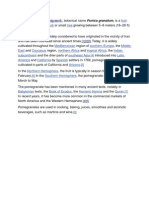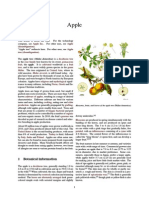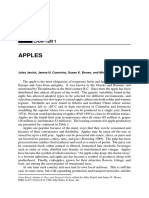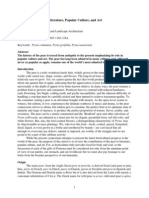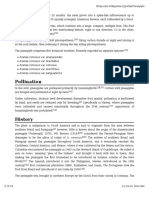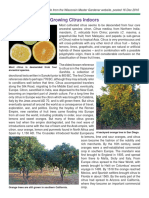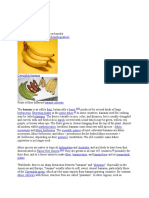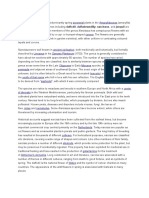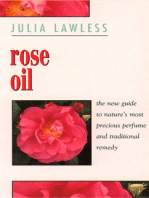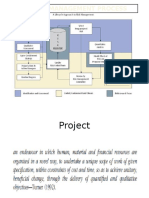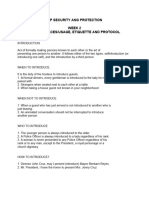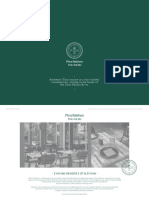Professional Documents
Culture Documents
Citation Needed
Citation Needed
Uploaded by
vabsOriginal Description:
Original Title
Copyright
Available Formats
Share this document
Did you find this document useful?
Is this content inappropriate?
Report this DocumentCopyright:
Available Formats
Citation Needed
Citation Needed
Uploaded by
vabsCopyright:
Available Formats
The peach (Prunus persica) is a deciduous tree native to the region of Northwest China between
the Tarim Basin and the north slopes of the Kunlun Mountains, where it was first domesticated
and cultivated.[3] It bears edible juicy fruits with various characteristics, most called peaches and
others (the glossy-skinned varieties), nectarines.
The specific name persica refers to its widespread cultivation in Persia (modern-day Iran), from
where it was transplanted to Europe. It belongs to the genus Prunus, which includes
the cherry, apricot, almond, and plum, in the rose family. The peach is classified with the almond
in the subgenus Amygdalus, distinguished from the other subgenera by the corrugated seed
shell. Due to their close relatedness, the kernel of a peach stone tastes remarkably similar to
almond, and peach stones are often used to make a cheap version of marzipan, known
as persipan.[4]
Peaches and nectarines are the same species, though they are regarded commercially as
different fruits. The skin of nectarines lacks the fuzz (fruit-skin trichomes) that peach skin has; a
mutation in a single gene (MYB25) is thought to be responsible for the difference between the
two.[5][6]
In 2018, China produced 62% of the world total of peaches and nectarines.[7]
It is also found elsewhere in Western Asia in ancient times.[18] Peach cultivation reached Greece
by 300 BC.[14] Alexander the Great is sometimes said to have introduced them into Greece after
conquering Persia,[18] but no historical evidence for this claim has been found.[19] Peaches were,
however, well known to the Romans in the first century AD;[14] the oldest known artistic
representations of the fruit are in two fragments of wall paintings, dated to the first century AD,
in Herculaneum, preserved due to the Vesuvius eruption of 79 AD, and now held in the National
Archaeological Museum in Naples.[20] Archaeological finds show that peaches were cultivated
widely in Roman northwestern Continental Europe, but production collapsed around the sixth
century; some revival of production followed with the Carolingian Renaissance of the 9th
century.[21]
An article on peach tree cultivation in Spain is brought down in Ibn al-'Awwam's 12th-century
agricultural work, Book on Agriculture.[22] The peach was brought to the Americas by Spanish
explorers in the 16th century, and eventually made it to England and France in the 17th century,
where it was a prized and expensive treat. Horticulturist George Minifie supposedly brought the
first peaches from England to its North American colonies in the early 17th century, planting them
at his estate of Buckland in Virginia.[23] Although Thomas Jefferson had peach trees at Monticello,
American farmers did not begin commercial production until the 19th century in Maryland,
Delaware, Georgia, South Carolina, and finally Virginia.[citation needed]
The Shanghai honey nectar peach was a key component of both the food culture and agrarian
economy the area where the modern megacity of Shanghai stands. Peaches where the
cornerstone of early Shanghai’s garden culture. As modernization and westernization swept
through the city the Shanghai honey nectar peach nearly disappeared completely. Much of
modern Shanghai is built over these gardens and peach orchards.[24]
You might also like
- Philippine Trees 101: Trees With Description PDFDocument10 pagesPhilippine Trees 101: Trees With Description PDFDerrick Yson (Mangga Han)100% (2)
- Application of MatricesDocument6 pagesApplication of MatricesStep To Success Tutorials40% (5)
- The History of DurianDocument2 pagesThe History of DurianMarc Nixon PelayoNoch keine Bewertungen
- PlumsDocument1 pagePlumssfsdfsdNoch keine Bewertungen
- Persea Americana, or The Avocado, Is Believed To Have Originated in The State ofDocument1 pagePersea Americana, or The Avocado, Is Believed To Have Originated in The State ofPei LingNoch keine Bewertungen
- Deciduous Tree Native Northwest China Tarim Basin Kunlun Shan MountainsDocument1 pageDeciduous Tree Native Northwest China Tarim Basin Kunlun Shan MountainsAlexandra MayerNoch keine Bewertungen
- History: Pliny's Natural History de Re CoquinariaDocument2 pagesHistory: Pliny's Natural History de Re CoquinariaTommy2Noch keine Bewertungen
- Orange HistoryDocument1 pageOrange HistoryBrianNoch keine Bewertungen
- VanillaDocument19 pagesVanillaAsanka LakmalNoch keine Bewertungen
- PomegranateDocument1 pagePomegranateSumeet DudaniNoch keine Bewertungen
- ApfelDocument16 pagesApfelthippliNoch keine Bewertungen
- File 10Document15 pagesFile 10Ethan HuntNoch keine Bewertungen
- The Annonaceous Fruits Being the Cherimoya, Bullock's Heart, Ilama, Papaya, Soursop and Sugar-Apple Found in the TropicsFrom EverandThe Annonaceous Fruits Being the Cherimoya, Bullock's Heart, Ilama, Papaya, Soursop and Sugar-Apple Found in the TropicsNoch keine Bewertungen
- Rhubarb 1Document1 pageRhubarb 1voraciouscommentsNoch keine Bewertungen
- HistoryDocument1 pageHistorymansi bavliyaNoch keine Bewertungen
- Ornamental PlantsDocument21 pagesOrnamental Plantsmikhael manaluNoch keine Bewertungen
- Pineapple: Ananas ComosusDocument25 pagesPineapple: Ananas ComosusJethro MiñanoNoch keine Bewertungen
- Berries Are GowingDocument1 pageBerries Are GowingidkNoch keine Bewertungen
- Pomegranate Wikipedia EnglishDocument24 pagesPomegranate Wikipedia EnglishMasyhadil AiniNoch keine Bewertungen
- Botanical Information: Apple Apple TreeDocument6 pagesBotanical Information: Apple Apple TreeadamNoch keine Bewertungen
- Apples Period 1Document25 pagesApples Period 1EllaNoch keine Bewertungen
- Fragaria × Ananassa 'Gariguette,' A Cultivar Grown in Southern FranceDocument1 pageFragaria × Ananassa 'Gariguette,' A Cultivar Grown in Southern FrancemanjuNoch keine Bewertungen
- The Pomegranate. Fruit of Paradise. Stover. 2007Document5 pagesThe Pomegranate. Fruit of Paradise. Stover. 2007Salma elfaNoch keine Bewertungen
- Apple FruitDocument5 pagesApple FruitTanvi PawarNoch keine Bewertungen
- AvacadoDocument3 pagesAvacadoTanvi PawarNoch keine Bewertungen
- Chapter 1, Apples, Jules, Fruit BreedDocument77 pagesChapter 1, Apples, Jules, Fruit BreedMayu FaicanNoch keine Bewertungen
- The Pear in History, Literature, Popular Culture, and ArtDocument14 pagesThe Pear in History, Literature, Popular Culture, and Artanast365Noch keine Bewertungen
- Pollination: Pineapple - WikipediaDocument1 pagePollination: Pineapple - WikipediaelmoelmoNoch keine Bewertungen
- Citrus IndoorsDocument6 pagesCitrus Indoorswillian01100% (1)
- Introduced Tree Species in EuropeDocument25 pagesIntroduced Tree Species in EuropeManea SilviuNoch keine Bewertungen
- Clade: Clade: Clade: Clade:: European Pear Branch With Two PearsDocument9 pagesClade: Clade: Clade: Clade:: European Pear Branch With Two PearsscribbbaNoch keine Bewertungen
- BananaDocument46 pagesBananatokagheru100% (1)
- Examples of GMODocument11 pagesExamples of GMOWends V. BaldicañasNoch keine Bewertungen
- The Book of Pears: Chapter 1 - The PearDocument20 pagesThe Book of Pears: Chapter 1 - The PearChelsea Green PublishingNoch keine Bewertungen
- Historical Background of Orange CultivationDocument39 pagesHistorical Background of Orange Cultivationjason manalotoNoch keine Bewertungen
- The Literature MineDocument1 pageThe Literature MineAllen wmsNoch keine Bewertungen
- Early History of The Avocado During The Time of The ConquistadoresDocument2 pagesEarly History of The Avocado During The Time of The ConquistadoresHạt Vừng LépNoch keine Bewertungen
- Tài LiêụDocument3 pagesTài Liêụlethuythaonguyen210Noch keine Bewertungen
- PoppyDocument4 pagesPoppyrkumar131350% (2)
- Plum (Prunus SPP.) Breeding: Tomo Miloševi C and Nebojša Miloševi CDocument51 pagesPlum (Prunus SPP.) Breeding: Tomo Miloševi C and Nebojša Miloševi Ctira flechasNoch keine Bewertungen
- The CarrotDocument5 pagesThe CarrotMaximos ManiatisNoch keine Bewertungen
- Maca's MonographDocument11 pagesMaca's MonographEdgarNoch keine Bewertungen
- Malus Malus Sieversii: - The Tree Originated inDocument26 pagesMalus Malus Sieversii: - The Tree Originated inKangLimNoch keine Bewertungen
- Banana Imports 1 On 1Document4 pagesBanana Imports 1 On 1keithNoch keine Bewertungen
- Tropicalia: Gardens With Tropical Attitude: Jeannie SimDocument24 pagesTropicalia: Gardens With Tropical Attitude: Jeannie SimAnisa Utami PermanaNoch keine Bewertungen
- P ApplesDocument1 pageP ApplespriyankaNoch keine Bewertungen
- StrawberryDocument3 pagesStrawberryTanvi PawarNoch keine Bewertungen
- Asparagus, its culture for home use and for market: A practical treatise on the planting, cultivation, harvesting, marketing, and preserving of asparagus, with notes on its historyFrom EverandAsparagus, its culture for home use and for market: A practical treatise on the planting, cultivation, harvesting, marketing, and preserving of asparagus, with notes on its historyNoch keine Bewertungen
- ElppaenipDocument18 pagesElppaenipMylene OrenseNoch keine Bewertungen
- History of GardensDocument22 pagesHistory of GardensJawed AmirNoch keine Bewertungen
- GrapesDocument1 pageGrapesAnnabelle ArtiagaNoch keine Bewertungen
- History: Wild AncestorsDocument2 pagesHistory: Wild AncestorspriyankaNoch keine Bewertungen
- Narcissus Is A: Narcissus Were Well Known inDocument1 pageNarcissus Is A: Narcissus Were Well Known inaashikapriya3037Noch keine Bewertungen
- Dried Poppy PodsDocument3 pagesDried Poppy PodsPoppy PodsNoch keine Bewertungen
- Wales, Wikipedia Founder: One-Time Monthly Select An Amount (USD) 3 5 10 20 30 50 100Document7 pagesWales, Wikipedia Founder: One-Time Monthly Select An Amount (USD) 3 5 10 20 30 50 100kjafjlfijesijNoch keine Bewertungen
- CloveDocument7 pagesCloveahmeda zayedNoch keine Bewertungen
- Durian For HawaiiDocument22 pagesDurian For HawaiiPutchong SaraNoch keine Bewertungen
- Fil 12345Document2 pagesFil 12345vabsNoch keine Bewertungen
- Implied Duties and Obligations in Construction Contracts: Chapter FourDocument32 pagesImplied Duties and Obligations in Construction Contracts: Chapter FourvabsNoch keine Bewertungen
- From Digital Tools To Manufactured Components: Data Driven InfrastructureDocument62 pagesFrom Digital Tools To Manufactured Components: Data Driven InfrastructurevabsNoch keine Bewertungen
- Circular To Professional InstitutesDocument19 pagesCircular To Professional InstitutesvabsNoch keine Bewertungen
- Enviornmental Impact Assessment: Environmental Baseline DataDocument1 pageEnviornmental Impact Assessment: Environmental Baseline DatavabsNoch keine Bewertungen
- Students Who Have Not Submitted Their Complete Student Exit Form For Batch May' 2016, Will Not Be Granted ADocument1 pageStudents Who Have Not Submitted Their Complete Student Exit Form For Batch May' 2016, Will Not Be Granted AvabsNoch keine Bewertungen
- 0ad4CRC Notice.28 Oct 2014 (Transport Arrangements)Document1 page0ad4CRC Notice.28 Oct 2014 (Transport Arrangements)vabsNoch keine Bewertungen
- Issues and Solutions in Managing Virtual TeamsDocument6 pagesIssues and Solutions in Managing Virtual TeamsvabsNoch keine Bewertungen
- Class 16Document29 pagesClass 16vabsNoch keine Bewertungen
- Feasibility of Bangalore Metro Rail Project (Namma Project)Document94 pagesFeasibility of Bangalore Metro Rail Project (Namma Project)vabsNoch keine Bewertungen
- The Gingerbread Man: Favorite Fairy Tales Children's StoriesDocument6 pagesThe Gingerbread Man: Favorite Fairy Tales Children's StoriesMohammed Rizwan AliNoch keine Bewertungen
- VIP Week 2 ReviewerDocument9 pagesVIP Week 2 ReviewerLovely Alyssa BonifacioNoch keine Bewertungen
- Rizal and The Lessons His Mother Taught HimDocument2 pagesRizal and The Lessons His Mother Taught HimMaybelle BernalNoch keine Bewertungen
- Low Microbial Diet BookletDocument17 pagesLow Microbial Diet Bookletsneaker.kemNoch keine Bewertungen
- Cinnamon Sugar Swirl Cupcakes - BEST Homemade Cinnamon CupcakesDocument3 pagesCinnamon Sugar Swirl Cupcakes - BEST Homemade Cinnamon Cupcakesr724zkh2bnNoch keine Bewertungen
- Contoh Personal LetterDocument9 pagesContoh Personal LetterRusdi FebriantoNoch keine Bewertungen
- Anti-Inflammatory Hot Coco With Turmeric & Ginger - The Dr. Oz ShowDocument1 pageAnti-Inflammatory Hot Coco With Turmeric & Ginger - The Dr. Oz Showcecytetics1eNoch keine Bewertungen
- Hoja de Respuestas Ingles VIDocument7 pagesHoja de Respuestas Ingles VIisabella sierra sotoNoch keine Bewertungen
- Barrel Oven BookDocument98 pagesBarrel Oven BookAlessandroLodovichi100% (2)
- Darul Uloom Halal ListDocument16 pagesDarul Uloom Halal Listjameel babooramNoch keine Bewertungen
- Cookery 11 q1 w3 Mod3Document23 pagesCookery 11 q1 w3 Mod3romarchristianorigenesNoch keine Bewertungen
- Narrative Report: Group 4 First TrialDocument2 pagesNarrative Report: Group 4 First TrialLucky MimNoch keine Bewertungen
- Worksheet Week 2 MondayDocument4 pagesWorksheet Week 2 Mondaynitid laohawannaratNoch keine Bewertungen
- Full Chapter Freefall America Free Markets and The Sinking of The World Economy 1St Edition Stiglitz Joseph E PDFDocument24 pagesFull Chapter Freefall America Free Markets and The Sinking of The World Economy 1St Edition Stiglitz Joseph E PDFjames.walker947100% (10)
- Stardew Valley Spreadsheet 1.5 With Item ChecklistDocument34 pagesStardew Valley Spreadsheet 1.5 With Item Checklistfane.dorobantu2025Noch keine Bewertungen
- Egg, Basket, Easter Egg Hunt, Easter Cake, Chicks, Lamb, Duckling, Spring. Choose Four Favourite Words and Represent ThemDocument1 pageEgg, Basket, Easter Egg Hunt, Easter Cake, Chicks, Lamb, Duckling, Spring. Choose Four Favourite Words and Represent ThemAntonia Michaela IonNoch keine Bewertungen
- Phra Nakhon MenuDocument23 pagesPhra Nakhon MenuNatdanai VisithyothinNoch keine Bewertungen
- Full Download Solution Manual For Ethical Obligations and Decision Making in Accounting Text and Cases Mintz Morris 3rd Edition PDF Full ChapterDocument34 pagesFull Download Solution Manual For Ethical Obligations and Decision Making in Accounting Text and Cases Mintz Morris 3rd Edition PDF Full Chapterpratic.collopvg0fx100% (23)
- Exercícios Aula 1 InglêsDocument3 pagesExercícios Aula 1 InglêsMarcos ViniciusNoch keine Bewertungen
- CHUYEN DE Thanh Ngu LUU HOANG TRI de BaiDocument9 pagesCHUYEN DE Thanh Ngu LUU HOANG TRI de BaiXuân AnhNoch keine Bewertungen
- Choco Puto Cheese RecipesDocument15 pagesChoco Puto Cheese RecipesCristina MelloriaNoch keine Bewertungen
- Assignment On FMCG Sector in Bangladesh: Southeast UniversityDocument39 pagesAssignment On FMCG Sector in Bangladesh: Southeast UniversityMd AdnanNoch keine Bewertungen
- Instant Download Management Fundamentals Concepts Applications and Skill Development 7th Edition Lussier Solutions Manual PDF Full ChapterDocument32 pagesInstant Download Management Fundamentals Concepts Applications and Skill Development 7th Edition Lussier Solutions Manual PDF Full ChapterAngelaHarveyofgz100% (12)
- Recipe No.1:: DR - Elchuri's Recipes For COMPLEXIONDocument10 pagesRecipe No.1:: DR - Elchuri's Recipes For COMPLEXIONkopparthiNoch keine Bewertungen
- Course: Post Harvest Management and Value Addition of Fruits and VegetablesDocument36 pagesCourse: Post Harvest Management and Value Addition of Fruits and VegetablesrahulNoch keine Bewertungen
- Get Ready For Second Grade WorkbookDocument92 pagesGet Ready For Second Grade WorkbooktraceyNoch keine Bewertungen
- Randfile 02Document32 pagesRandfile 02Sergio DiazNoch keine Bewertungen
- Some Positive AnswersDocument1 pageSome Positive AnswersBele Agreste100% (1)
- Aeration of Cereal Dough by YeastDocument13 pagesAeration of Cereal Dough by Yeastkolita kamal100% (1)









